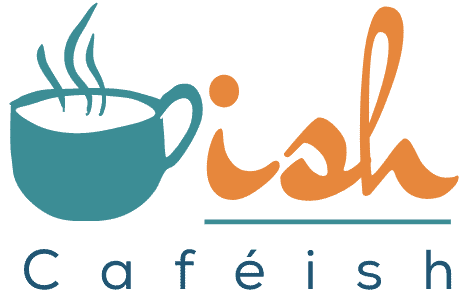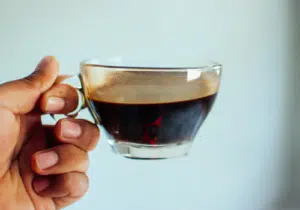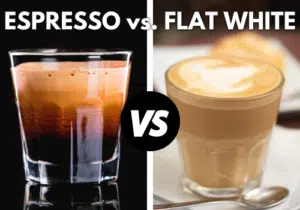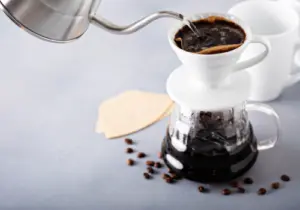Mocha vs Latte vs Cappuccino: 5-Minute Read
Disclosure: This post contains affiliate links and I may earn a small commission (at no extra cost to you) if you click through and make a purchase. Thanks in advance – I really appreciate it!
There are way too many different espresso-based coffee beverages and it is easy to get them confused.
Trust me I completely understand the feeling of standing in line at a coffee shop, a little too early in the morning, staring up at this menu that might as well be written in a foreign language.
If you’re like most of my friends who are embarrassed to ask the barista to explain the difference between a mocha, latte, and a cappuccino, then here’s your answer.
Mocha vs Latte vs Cappuccino
Mocha, latte & cappuccino are all espresso-based beverages. Mocha has a chocolate flavor and it is made with 2/5 espresso, 2/5 chocolate, 1/5 steamed milk. Latte is made with 1/6 espresso, 4/6 steamed milk, 1/6 foamed milk, whereas cappuccino has ⅓ espresso, ⅓ steamed milk, and ⅓ foamed milk.
Key Takeaways:
- A latte is a coffee drink that is made by combining a shot of espresso with steamed milk and topping it with a layer of foamed milk to give it a bit more texture.
- A cappuccino, uses only half as much milk as a latte, but the volume of the liquid doubles in size due to a different steaming technique in which more air is introduced to the milk.
- Mocha is short for a “mocha latte” or a “caffe mocha,” which is just a regular latte with chocolate syrup added to it.
- Mocha has the most amount of caffeine among the three as mocha is made with two shots of espresso.
Although all the three beverages come from the same ingredient – the mighty espresso, they have a lot of differences in taste, texture, and in their preparation.
In this article, I will explain each one of them in detail and I will also teach you how you can make them in your own kitchen.
But to make the right one for the right occasion, you need to know all the differences between the three. That’s why I’ve created this comparison guide to help you make a perfect choice.
Latte vs Cappuccino vs Mocha
(At a glance)
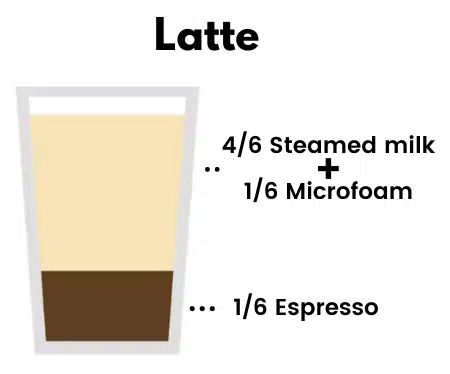
- Origin: Italy
- Ingredients: 1/6 espresso, 4/6 steamed milk, 1/6 foamed milk
- Strength: Light
- Taste: Mild, Milky, Creamy
- Service: Latte mug
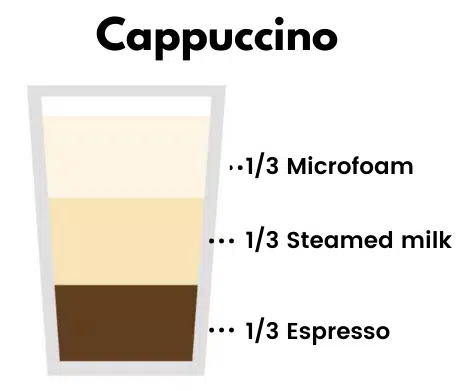
- Origin: Italy or Austria
- Ingredients: Espresso, Steamed Milk, Microfoam (⅓ each)
- Strength: Medium-Strong
- Taste: Fluffy, Espresso, Creamy, Balanced
- Service: Ceramic Cappuccino Mug
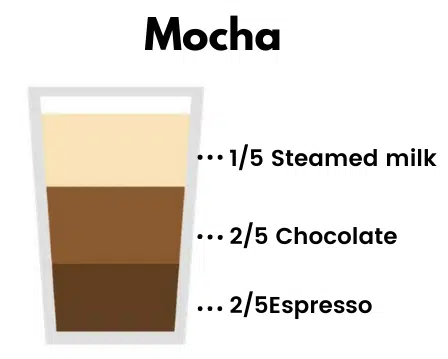
- Origin: United States
- Ingredients: ⅖ Espresso, ⅕ Steamed milk, ⅖ Hot chocolate
- Strength: Medium-Strong
- Taste: Strong, Bold, Rich, Sweet
- Service: Mocha mug
The difference between a Cappuccino and Latte are simple: both have Espresso and milk, but the milk content is what makes the difference. The Latte has more, and has a creamier taste.
The most notable difference between a cappuccino and a latte is the texture of the milk, in that the steamed milk of the latte is thinner, while a cappuccino is full of froth.
Another key distinction is that cappuccinos use less milk than lattes—namely because cappuccino milk fluffs up so much from all the aeration, and the drink is intended to be served in a smaller size.
All a Mocha brings is the addition of chocolate (usually syrup), and a variety of toppings such as whipped cream, chocolate shavings and powder, cinnamon or nutmeg.
What is Latte?
A latte is a coffee drink that is made by combining a shot of espresso with steamed milk and topping it with a layer of foamed milk to give it a bit more texture.
A latte is formed by combining three things: espresso (1/6 or 1-2 shots) + steamed milk (4/6 or 5-6 oz.) + milk foam (1/6 or a thin top layer).
Thanks to the milk, this drink is ultra-creamy and is often described as having a velvety texture.
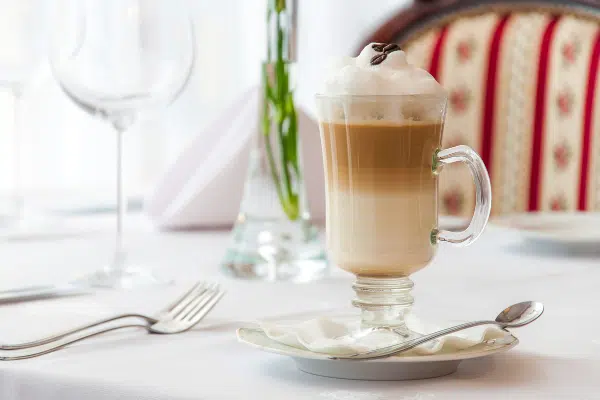
The latte is extremely delicious when done right. The espresso and steamed milk combination are already extremely delicious, but the foamed milk on top brings it to the next level.
Adding foamed milk on top gives the coffee its edge to distinguish itself from all the other coffee drinks.
The term “latte” comes from shortening the Italian term caffé latte, meaning “milk coffee”- an appropriate title for this drink dairy-based drink.
It is typically served in an 8-ounce cup and offers a gentler but still caffeinated wake-me-up to latte lovers.
You can also check out my article that reviews some of the best espresso machines for latte lovers. That article has an espresso machine for every budget and need.
How to Make a Latte?
But first we need the ESPRESSO!
To make a latte, mocha or a cappuccino you’ll need to make espresso, simply strong coffee will not do!
This means you’ll either need an espresso machine, a manual espresso maker, or an Aeropress.
There are several ways to make espresso. I use the best-selling Breville BES870XL Barista Express Espresso Machine, which sits on a countertop.
Or you can use a small manual espresso maker: it’s cheaper and portable!
The cheapest option is an Aeropress Coffee Maker: it doesn’t make nearly as good of espresso, but it does the job.
Now let’s get back to making our beloved latte!
A latte is a perfect choice for those who like a coffee that is a bit more milk-focused but still has enough flavor to get that balanced coffee flavor throughout the drink.
You’ll need the following items:
- 1/2 cup (0.12 l) of steamed whole milk
- 2 oz (60 grams) of foamed milk
- 1 shot of espresso
For this recipe, you’ll need more steamed milk and a bit of foamed milk, and just one shot of espresso.
Now follow the below recipe to make a perfect cup of latte:
- Prepare your espresso shot, and in the meantime, steam your milk.
- Add the espresso to a tall glass.
- Slowly pour the steamed milk on top.
- Now, foam the remaining milk.
After the milk has been foamed, pour this on top of the steamed milk. This will create a three-layered coffee that looks stunning.
Make latte, mocha or a cappuccino at home with Breville Cafe Milk Frother.
- For those who want to make a latte at home, one of the biggest challenges is frothing the milk. Nailing a perfect texture and temperature of your foamed milk is not that easy, and many give up before even trying.
- One of the best options on the market is the Breville milk frother. The unit comes with separate frothing disks for latte and cappuccino, and it automates the process to pressing a couple of buttons and adjusting the dial button.
Prices pulled from the Amazon Product Advertising API on:
Product prices and availability are accurate as of the date/time indicated and are subject to change. Any price and availability information displayed on [relevant Amazon Site(s), as applicable] at the time of purchase will apply to the purchase of this product.
Here’s a video to help you make a delicious, velvety latte.
What is Cappuccino?
A cappuccino, uses only half as much milk as a latte, but the volume of the liquid doubles in size due to a different steaming technique in which more air is introduced to the milk.
Ideally, or traditionally speaking, a cappuccino is meant to be a perfect ratio of the components: 1/3 espresso, 1/3 milk, 1/3 milk foam.
So in an ideal cup of cappuccino, you have a generous amount of microfoam—sort of like the head of a beer— on the surface of the steamed milk and the beverage.
Cappuccino is usually served in a 5 or 6-ounce size, and as I mentioned before, it consists of three distinct and equal layers: Espresso at the bottom, steamed milk in the middle and rich, airy froth on top.
How To Make a Cappuccino?
Now that you know what cappuccino is, it’s time to learn how to make one.
Listed down are the cappuccino ingredients and things we need to make our perfect cup.
- 1 shot of espresso
- Steamed milk
- Foamed milk
Here’s the recipe.
- Prepare your espresso shot, and in the meantime, steam your milk in a pitcher.
- After steaming and frothing, you need to swirl the milk around the pitcher, to make sure the micro foam is together.
- Pour espresso in to a 5-6 ounce cup or a mug.
- To pour the milk over espresso, steady your hands on top of the cup.
- Pour the milk from the centre, low height from the cup with slight wiggle. And once the micro foam starts to pour, just tilt the pitcher a bit, towards the cup.
Voila! Your cappuccino is ready to be served!
Here’s a video tutorial to help you make an awesome cappuccino.
What is Mocha?
Mocha is short for a “mocha latte” or a “caffe mocha,” which is just a regular latte with chocolate syrup added to it. One of the great reasons why many coffee fanatics love the latte is because they are customizable, and the mocha is a prime example of that.
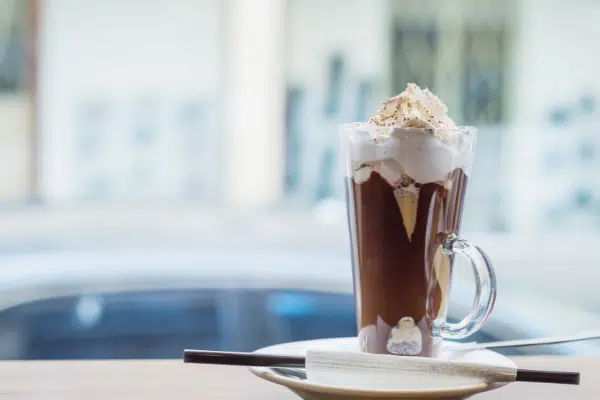
A mocha is typically made with a double shot of espresso, chocolate (syrup, drinking chocolate, or shavings) and steamed milk with a little bit of milk foam.
Depending on customer preference and the café or barista serving it, the drink may be served as is, or topped with a dusting of cocoa powder, whipped cream, chocolate syrup/shavings, or marshmallows.
You can also vary the flavour of a mocha by changing the type of chocolate you use. While mochas are often made using high-cocoa chocolate, this does not have to be the case.
Mochas can be created with white chocolate (a white mocha), or even by combining white and dark chocolate.
How To Make Mocha?
The steps to make a mocha are extremely similar to that of making latte. With an espresso machine at home, making cafe mocha is super simple.
Before you begin brewing, it’s important to gather your ingredients, which we’ve made a list for you below.
- 2 espresso shots
- 2 tablespoons of chocolate syrup
- 1 ounce of steamed milk
Here’s the recipe to make mocha:
- Prepare your espresso shot, and in the meantime, steam your milk in a pitcher.
- Pour chocolate syrup in to a mug and extract 2 shots of espresso over it.
- When the espresso is finished extracting, you should thoroughly stir the two together to adequately blend the flavors together.
- After you’ve steamed your milk, you can pour it into your cup on top of your chocolate & espresso mixture. There should be a thin layer of foam on the surface, providing you with a smooth, slightly velvety texture with each sip.
To decorate your mocha, you can add whipped cream, milk, dark or white chocolate syrup, sprinkles, nutmeg, cinnamon, and even chocolate sprinkles!
Here’s a video to guide you in making a warm delicious mug of cafe mocha!
Mocha vs Latte vs Cappuccino: Caffeine
Mocha has the most amount of caffeine among the three as mocha is made with two shots of espresso, where as both latte and cappuccino are typically made with just one shot of espresso.
A 2-ounce shot of espresso generally has 80mg of caffeine, and most cafes use 2 shots of espresso to make a standard mug of mocha. So it’s safe to assume that a mug of cafe mocha will have around 160mg of caffeine, most of it coming from 2 shots of espresso and then some from chocolate syrup.
Latte and cappuccino, on the other hand are made with just 1 shot of espresso, so they typically have around 80mg of caffeine per serving.
Though keep in mind that caffeine levels can vary slightly due to bean variety, extraction time and a number of other factors, so in reality both drinks won’t have exactly the same amount of caffeine, but close enough.
Mocha vs Latte vs Cappuccino: Taste
Latte has a creamier, milky texture with a mild taste of coffee, while mocha is sweet like chocolate but with the roasty qualities of a cup of coffee. Cappuccino, on the other hand, has a velvety texture and a sweeter and more balanced taste of coffee.
However, mochas have a difficult taste to describe because it tastes so different from other types of coffee you may be used too.
Unlike other espresso drinks, it is longer and thicker. Mocha also tastes different depending on the type of chocolate syrup used in a recipe which makes this coffee-based drink even more difficult to describe.
A Latte is quite a mild tasting coffee, as the drink has more milk than any other Espresso based coffee. The Espresso shot can even get lost within the milkiness, especially if it has a lighter roast profile.
Mocha vs Latte vs Cappuccino: Calories
Mocha has the most calories as it has additional chocolate and is often served with whipped cream or marshmallows. A 16 ounce serving of mocha can have upto 430 calories, while a 16 ounce serving of cappuccino has 190 calories and an 8 ounce cappuccino generally has 80 calories.
A cappuccino will likely have fewer calories because it has less milk.
As soon as you add milk, creamer, or sugar, you add tons of calories. With a tiny splash of milk, you 4x your calorie intake. Most people add a few splashes… and a little sugar.
Non-fat milk or alternative milks like almond, coconut, or oat milk are also great options for these drinks.
Mocha vs Latte vs Cappuccino: Which one is healthier?
This depends on your definition of “healthy.” Although there’s nothing necessarily unhealthy about milk, chocolate, marshmallows and other extra toppings on mocha may be considered unhealthy.
So, if you consider calories coming from fat content of milk and sugar from chocolate and toppings, then a mocha could be definitely considered the less ‘healthy’ option among the three beverages.
Since a cappuccino has the least amount of milk in it and consequently least amount of calories, so it can be considered as the healthiest among the three.
Mocha vs Latte vs Cappuccino: Which is stronger?
Mocha is the strongest among the three as it is typically made with two shots of espresso. Cappuccino has smaller amount of milk used in its preparation so it tastes stronger than latte. Latte is the weakest as is a very light drink, with little coffee per ounce of milk.
Keep in mind that the strength here is simply a measure of how much you taste the bite of the espresso in the beverage. In other words, the milky latte has a far mellower flavor by comparison.
Milk for Mochas, Lattes & Cappuccinos
Espresso drinks are popular beverages — and for good reason. They are warm, delicious, and easy to customize.
Aside from the espresso itself, the most common ingredient in traditional espresso drinks is milk or cream.
Milk is often frothed or steamed, changing its character in order to prepare drinks in the correct manner.
Milk steaming warms the milk so it does not chill the drink when the hot espresso is added. It is also necessary for making latte designs.
Milk frothing is done to prepare a delicious foam topping for drinks such as our favorites – lattes, mochas, and cappuccinos.
Frothed Milk vs Steamed Milk
Steamed milk is produced by heating the milk with the steam wand. Frothed milk is produced not only by heating the milk with the steam wand, but by using it to aerate the milk, creating small bubbles. The purpose of frothing milk is to add a creamy, airy mouthfeel to drinks.
Steamed Milk
Milk is steamed with the help of the steam wand on most espresso machines. These wands are topped with a rubberized cover that should be removed prior to use.
The desired amount of milk is poured into the steamer carafe, a stainless steel pitcher. The steamer tip is placed into the milk and steam is slowly released from the machine.
Control is important to prevent hot milk from spraying out of the pitcher or splashing uncontrollably.
Frothed Milk
Frothed milk is made by aerating milk, meaning adding air bubbles. The aeration process is what makes foam or froth. The purpose of frothing milk is to achieve a certain texture. High-quality foam should be dense and fluffy.
Making frothed milk at home is actually fairly easy. You can use a jar or whisk, or purchase a dedicated milk frother, some of which are handheld. Because basic frothing doesn’t involved heat, you’ll have to heat the milk separately for hot drinks like lattes.
- Bodum Latteo is an inexpensive device, that is easy to use, and it doesn’t need electricity or batteries. The carafe is made of borosilicate glass, which is great to withstand thermal shock.
- The screen is designed just right to maximize the efficiency during frothing.
- The plunger’s knob is easy to hold and operate, and the carafe handle makes it even easier. This mesh milk frother is very similar to a French press: a glass pitcher, a plunger, and a screen.
Prices pulled from the Amazon Product Advertising API on:
Product prices and availability are accurate as of the date/time indicated and are subject to change. Any price and availability information displayed on [relevant Amazon Site(s), as applicable] at the time of purchase will apply to the purchase of this product.

Amit Gupta
Hi, my name is Amit Gupta, and I am the owner and contributor at Cafeish. My obsession with coffee started when I received my first French press as a gift almost ten years ago. Since then, my love of coffee – and the number of coffee gadgets I own – has grown considerably.
Most Popular
ABOUT US
We are a team of coffee affcianados with experience and expertise in making world renowned coffee. In fact, preparing the best coffee ever with a fluffy top reminds us of magic, with secrets of how to achieve each particular effect. Making coffee is not our only hobby, we always keep our ears open as to what’s happening around and what scientists and manufacturers produce for consumers. It’s not an easy task to do – it’s rather time consuming. Hence, Caféish website was launched.
LEGAL DISCLAIMER
Caféish is a participant in the Amazon Services LLC Associates Program, an affiliate advertising program designed to provide a means for sites to earn advertising fees by advertising and linking to Amazon.com. Caféish also participates in affiliate programs with Clickbank and other sites. Caféish is compensated for referring traffic and business to these companies.
